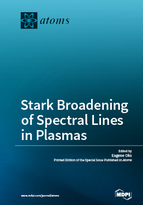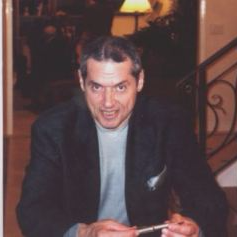Stark Broadening of Spectral Lines in Plasmas
A special issue of Atoms (ISSN 2218-2004).
Deadline for manuscript submissions: closed (31 July 2018) | Viewed by 38128
Special Issue Editor
Interests: atomic, molecular and optical physics; laser physics; plasma physics; astrophysics; nonlinear dynamics; fundamentals of quantum mechanics
Special Issues, Collections and Topics in MDPI journals
Special Issue Information
Dear Colleagues,
Laboratory and astrophysical plasmas contain various types of electric fields, such as the ion microfield, the electron microfield, fields of different kinds of the electrostatic plasma turbulence, and laser/maser fields penetrating into plasmas. All these kinds of electric fields, differing by their statistical properties, strength, frequency, and possible polarization, cause a garden variety of the types of Stark broadening of spectral lines in plasmas. Therefore, experimental and theoretical studies of Stark broadening of spectral lines in plasmas are the cornerstone of a large number of spectroscopic diagnostics of laboratory and astrophysical plasmas. As such, they are very important both fundamentally and practically, the latter being due to numerous practical applications of plasmas: from the controlled thermonuclear fusion to plasma-based lasers and plasma sources of incoherent x-ray radiation, as well as technological microwave discharges. The purpose of this Special Issues of Atoms is to review advances in this area achieved in recent years, as well as to present new original papers building up on these advances. It is intended to publish this Special Issue also as a book.
Prof. Dr. Eugene OksGuest Editor
Manuscript Submission Information
Manuscripts should be submitted online at www.mdpi.com by registering and logging in to this website. Once you are registered, click here to go to the submission form. Manuscripts can be submitted until the deadline. All submissions that pass pre-check are peer-reviewed. Accepted papers will be published continuously in the journal (as soon as accepted) and will be listed together on the special issue website. Research articles, review articles as well as short communications are invited. For planned papers, a title and short abstract (about 100 words) can be sent to the Editorial Office for announcement on this website.
Submitted manuscripts should not have been published previously, nor be under consideration for publication elsewhere (except conference proceedings papers). All manuscripts are thoroughly refereed through a single-blind peer-review process. A guide for authors and other relevant information for submission of manuscripts is available on the Instructions for Authors page. Atoms is an international peer-reviewed open access monthly journal published by MDPI.
Please visit the Instructions for Authors page before submitting a manuscript. The Article Processing Charge (APC) for publication in this open access journal is 1500 CHF (Swiss Francs). Submitted papers should be well formatted and use good English. Authors may use MDPI's English editing service prior to publication or during author revisions.
Keywords
- Stark broadening in general
- Stark broadening by electrostatic plasma turbulence
- Correlations between various types of Stark effect
- Correlations between Stark and other broadening effects
- Spectral line shapes and shifts
- Spectroscopic diagnostics of plasmas
- Laboratory plasmas
- Astrophysical plasmas
- Fusion plasmas
- Laser-plasma interactions
- Plasma-based lasers
- Plasma sources of incoherent x-ray radiation
- Technological microwave discharges






